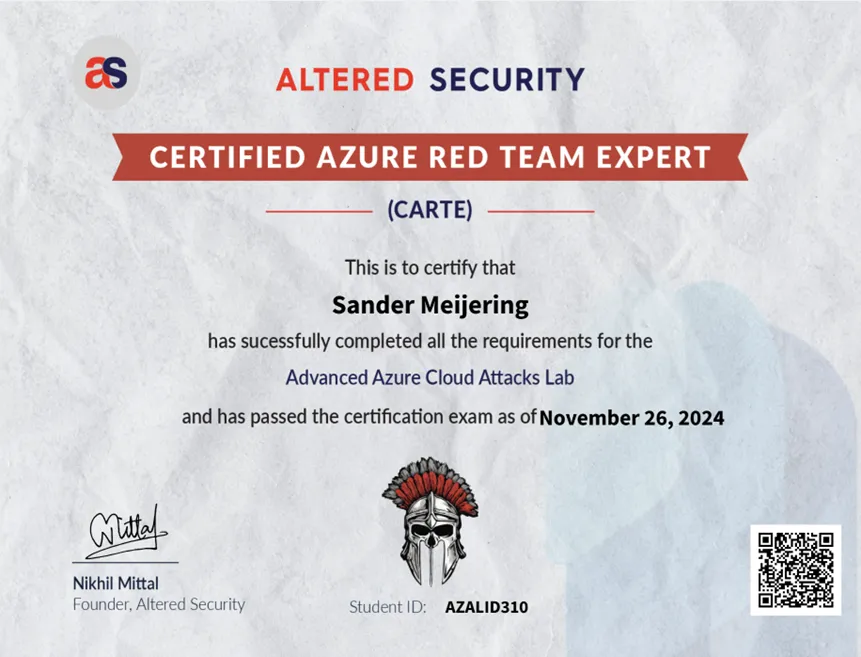Wij zijn |
Certified Azure Red Team Expert (CARTE) review
Azure is becoming increasingly popular, especially with the widespread use of Microsoft 365, Microsoft Intune, Microsoft Entra ID, and resources like Function Apps and Storage Accounts. A few years ago, I decided to take a course focused on red team attacks against Azure environments. This course, called Certified Azure Red Team Professional (CARTP), provided valuable insights into various attack techniques through hands-on labs and exams, helping me develop a deeper understanding of Azure security.
As Azure continues to evolve—such as the rebranding of Azure AD to Entra ID—new attack techniques are constantly emerging. To keep up with these changes, Altered Security introduced an advanced follow-up course to CARTP: the Certified Azure Red Team Expert (CARTE). Having completed and passed this course, I’d like to share my experience in this review.
Certified Azure Red Team Expert (CARTE) review
Course overview
The CARTE course follows the same structured approach as other Altered Security training programs. Since I was already familiar with their teaching style from the CARTP course, I found the format consistent and effective. The course includes:
✅ Slides and video lessons for theoretical explanations
✅ Demos showcasing attack techniques
✅ Hands-on labs for practical application
One of the best aspects of the course is its interactive and practical approach. Every concept introduced is immediately tested in a lab environment, reinforcing both understanding and execution. Throughout the course, you’ll encounter questions (flags) related to each assignment. These flags can only be answered correctly if you successfully complete the task, ensuring that you truly grasp and apply the techniques. You submit your answers via an online portal, which also tracks your progress. This learn-apply-validate cycle enhances engagement and effectiveness, making the course both enjoyable and highly educational.
Among the most interesting topics for me were the phishing techniques that bypass security measures like Conditional Access MFA, particularly Device Code Phishing. Additionally, the detailed explanations on authentication tokens and Graph API enumeration using PowerShell were incredibly insightful.
Exam experience
The CARTE exam is a 48-hour hands-on assessment designed to test the knowledge and skills gained from the course. The challenge lies in compromising all Azure objects (resources and user accounts) and capturing the final flag.
One of the best aspects of the exam is that it goes beyond the course material, pushing you to discover new attack techniques on your own. The course provides an excellent foundation, but the exam requires adaptability and problem-solving skills to succeed.
Key challenges of the exam:
- No pre-installed tools—you must set them up yourself
- Full enumeration of the Azure environment is crucial
- Heavy reliance on Microsoft Graph API for reconnaissance
At one point, I was stuck on an object for a long time. The breakthrough came when I decided to re-enumerate the entire environment using Graph API, leading me to the missing piece. This highlights how important it is to be thorough in your enumeration process.
After completing the practical portion, you have an additional 48 hours to submit a detailed exam report, documenting your findings and attack methodologies.
Conclusion
For those who have already completed CARTP and want to elevate their Azure red teaming skills, I highly recommend CARTE. The course covers advanced attack techniques in great detail, and I guarantee you’ll learn new methods you haven’t encountered before.
Finally, a huge shout-out to Nikhil from Altered Security for developing such a well-structured and informative course!
Hoe kunnen wij u helpen?
Offensive Entra ID (Azure AD) and Hybrid AD security – Outsider Security review
In this blog post, I share my personal journey and insights from undertaking the Certified Azure Red Team Expert (CARTE) certification offered by Altered Security.
The WiFi Pineapple: Basic Usage
The Wi-Fi Pineapple, developed by Hak5, is a powerful tool designed for wireless network auditing. Its versatility makes it ideal for red teamers and physical pentesters who need to assess wireless environments quickly and efficiently. In this blog post, we’ll go through the basic usage of the Wi-Fi Pineapple, explain how it works, and demonstrate its potential in a controlled test scenario.
TPM‑sniffing with Saleae logic analyzer [2025]
Learn how to use a Saleae logic analyzer to intercept TPM-chip SPI communication and extract the Volume Master Key (VMK) in this practical, step‑by‑step guide. Essential for cybersecurity professionals aiming to strengthen hardware defenses.








